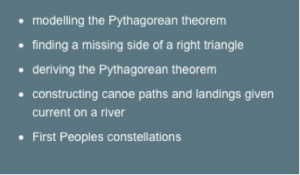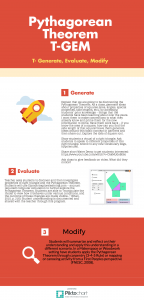ETEC 533– T-GEM
Grade 8 Math – Pythagorean Theorem
One of the challenges I have encountered when teaching mathematics to Grade 8 students is their understanding of the Pythagorean Theorem. They are able to quickly memorize the “equation” but struggle with the conceptual understanding of the theorem. I have noticed that when students are given the equation they can solve it, but when given concrete objects or visuals they struggle. They also have the misconception that the Pythagorean Theorem applies to all triangles, and that the longest side of all triangles is the hypotenuse. I want to move students from general memorization to conceptual understanding.
B.C. Math 8 Content (2015):

3 step T-GEM:

Generating:
Explain that we are going to be discovering the Pythagorean Theorem. As a class, generate ideas about properties of squares (area, angles, special properties, side lengths, etc.), by accessing students’ prior knowledge – things that the students have been learning about over the years. I want them to make connections to what they already know and prime them for the new information to come. Have them work back – if you know the area of a square, how can you find the side length of that square? Have them generate ideas around this basic concept in partners and then share out. Explore the idea of square root.
Show students a visual of a right triangle. Ask students to speak to different properties of this right triangle. Attend to any new vocabulary (legs, hypotenuse).
Share short Water Demo to get students interested: https://www.youtube.com/watch?v=CAkMUdeB06o
Ask class to give feedback on video. What did they notice?
Evaluating:
Teacher asks students to discover and then investigate properties of right triangle and the Pythagorean Theorem. Students will use Gizmos (explorelearning.com – account required) computer simulation to further explore the Pythagorean Theorem. Students are able to “manipulate the model to view how it behaves under various conditions, and the outcome of these changes are made visible…” (Khan, 2010, p. 216). Student understanding is documented and shared with the teacher through this program.
Modifying:
Students will summarize and reflect on their understanding and apply this understanding in a different scenario. In a Makerspace or Woodwork setting have students apply the Pythagorean Theorem through carpentry (3-4-5 Rule) or mapping or canoeing activity from a First Peoples perspective (FNESC, 2008).
References
British Columbia Ministry of Education (2015). Mathematics 8. Retrieved from https://curriculum.gov.bc.ca/curriculum/mathematics/8
First Nations Education Steering Committee – FNESC (2008). Teaching Mathematics in a First Peoples Context: Grades 8 & 9. Retrieved from https://teachbcdb.bctf.ca/download/271?filename=math-first-peoples-mapping-and-transportation.pdf
Khan, S. (2010). New pedagogies for teaching with computer simulations. Journal of Science Education and Technology, 20(3), 215-232.